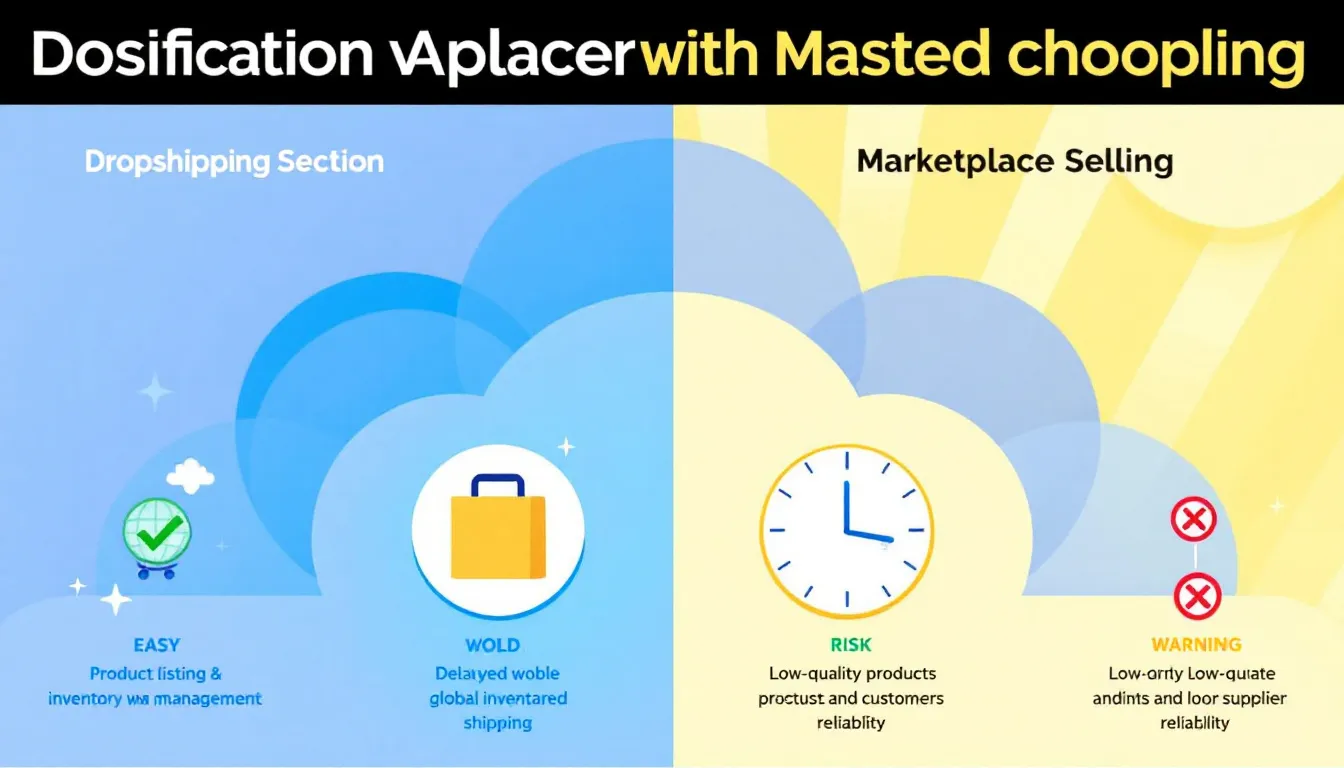
Dropship vs Marketplace: Finding the Best Model for Your Business
Share
When deciding between dropshipping and marketplaces for your ecommerce business, understanding their core differences is crucial. Dropshipping involves selling products without holding inventory, as suppliers handle storage and shipping. In contrast, marketplaces connect multiple sellers directly to consumers through a single platform. This article will explore these models, including dropship vs marketplaces such as ebay, amazon etsy, to help you make an informed choice.

Dropship vs Marketplace - Key Takeaways
- Dropshipping lets retailers sell without holding inventory, reducing risks and costs, while marketplaces connect multiple sellers to buyers on a single platform.
- Each model has its perks: dropshipping requires lower startup costs and offers flexibility, while marketplaces enable quick scaling and a diverse product range.
- Combining the two models can enhance offerings and customer reach but success hinges on strong supplier relationships and effective tech solutions for management.
Understanding Dropshipping and Marketplaces

Dropshipping and online marketplaces are two popular ecommerce business models that allow retailers to sell products online without maintaining inventory. In the dropshipping model, orders are sent directly to the supplier who then ships them to customers. Retailers thus avoid handling physical products, which reduces inventory risks and operating costs.
On the other hand, online marketplaces serve as platforms where multiple sellers can list their products and the marketplace operator facilitates transactions between these sellers and buyers. This model connects buyers with a wide range of third-party products, enabling a retail business to expand its product offerings without holding stock.
Both models aim to reduce inventory risks and leverage asset-light operations.
How Dropshipping Works
Dropshipping, an ecommerce fulfillment method, offers a streamlined way for retailers to operate. When a customer places an order, the merchant buys the product from a third-party supplier, who then handles warehousing, packaging and delivery directly to the customer. This process allows the merchant to focus on marketing and customer service, while the supplier takes care of the logistics.
One of the key aspects of the dropshipping model is that buyers are usually unaware of the third-party supplier’s involvement, as the product is shipped directly to the end customer. This seamless experience can enhance customer satisfaction, although it also means the retailer has less control over shipping details and product quality.
Benefits of Dropshipping
The dropshipping model presents numerous advantages for an ecommerce business. One of the biggest perks is the low initial investment required since there’s no need to purchase inventory upfront. This significantly reduces the financial risk for retailers and allows them to allocate resources to other areas, such as marketing and customer acquisition.
Dropshipping also allows businesses to offer a variety of products without the concern of unsold inventory. This flexibility helps retailers adapt quickly to market trends, offering customers the latest products and driving sales through drop ship methods.
Running a dropship business from any location with internet access adds to its appeal, providing greater operational flexibility.
Challenges of Dropshipping
Despite its many benefits, the dropshipping model comes with its own set of challenges. A significant drawback is the heavy reliance on suppliers, limiting retailers’ control over product quality and shipping times. This can result in inconsistencies in customer experience, potentially affecting customer loyalty and satisfaction.
Another challenge is the complexity of shipping, especially when customer orders include products from multiple suppliers. This can result in higher shipping costs and longer delivery times. Additionally, the intense competition in the dropshipping space often leads to lower profit margins for retailers. Effective inventory management can also be tricky, particularly if a supplier runs out of stock, leaving the retailer unable to fulfill orders.
How Marketplaces Work

Marketplaces operate as platforms connecting buyers and sellers through a single online platform. The marketplace operator manages the infrastructure, sets commissions and facilitates transactions. This model allows third-party sellers to manage their own product listings and customer interactions, providing them with autonomy over their branding and operations.
The marketplace model achieves faster growth by quickly adding vendors and products. Sellers are responsible for their inventory management and shipping, while the marketplace operator collects a commission on sales. This setup enables the marketplace to offer a diverse range of products, enhancing the shopping experience for customers.
Benefits of Marketplaces
Marketplaces provide numerous benefits for sellers and buyers. One major advantage is the ability to scale quickly, driven by network effects from multiple sellers on a single platform. This broader reach can result in increased sales and enhanced brand visibility for sellers.
Additionally, marketplaces can adapt to customer demands by curating a diverse range of products from various suppliers. This allows customers to find a wider variety of products in one place, improving their shopping experience. The scalability of marketplaces is further enhanced by delegating customer service and catalog management to third-party suppliers.
Challenges of Marketplaces
While marketplaces such as Amazon offer numerous benefits, they also come with challenges - sellers must navigate the variability in selling policies, which can affect their operations. Additionally, the competition within marketplaces can be intense, as multiple sellers often offer similar products, making it challenging to stand out.
Another issue is the reduced profit margins caused by commissions and listing fees charged by the marketplace operator. These costs can reduce sellers’ profits, requiring competitive retail price to maintain profitability.
Key Differences Between Dropshipping and Marketplaces

Understanding the key differences between the dropship model and the marketplace model is crucial for making informed business decisions. In dropshipping, merchants control branding and customer experience, allowing them to build a consistent brand image. Conversely, in a marketplace, third-party sellers manage their own branding and customer interactions.
Another significant difference is inventory management. Dropshipping retailers generally do not hold inventory, relying on suppliers for order fulfillment. In contrast, marketplace sellers manage their own stock, which can result in faster order fulfillment but also higher inventory risks - this is most common on Amazon where the large majority of sellers on there are 3rd-party sellers that private label their own products and use amazon's warehouse to store and fulfil their products.
These differences impact financial aspects like costs, pricing strategies and profit margins.
Choosing the Right Model for Your Business

Choosing the right business model depends on various factors, including startup costs, scalability and brand control. Dropshipping has low startup costs due to the lack of inventory, making it appealing for new entrepreneurs. Its scalability allows sellers to target global markets without worrying about inventory constraints.
Marketplaces also need a lower upfront investment and offer more exposure and sales opportunities with minimal risk. Combining dropshipping with marketplaces can enhance product offerings and better adapt to customer preferences.
Combining Dropshipping and Marketplaces

Using both dropshipping and marketplaces like Amazon and eBay can unlock significant potential for online retailers. This hybrid model merges the flexibility and low overhead of dropshipping with the massive audience reach of well-established marketplaces, enabling businesses to expand product offerings and attract more customers with minimal risk.
For example, a seller might list products from a dropshipping supplier directly on Amazon. By leveraging Amazon’s Fulfilled by Merchant (FBM) program, the seller avoids holding inventory, shipping items only when an order is placed. Suppose the supplier specializes in high-demand products like home fitness equipment. The seller can quickly tap into trending consumer needs without the financial burden of stocking and warehousing bulky inventory.
Similarly, on eBay, dropshippers can list niche products sourced from suppliers to cater to specialized audiences. For instance, a seller might use a dropshipping partner to offer rare or custom automotive accessories. eBay’s international reach and auction-style listings allow these products to attract a broad customer base while remaining competitive on price.

This hybrid approach also allows businesses to diversify. While a retailer may consistently dropship core items such as fashion or electronics on their own website, marketplaces like Amazon and eBay can serve as channels to test new product categories. For example, a seller focused on tech gadgets could experiment with selling pet accessories on eBay, analyzing market demand without committing to bulk orders.
Success in this model requires strong supplier relationships to ensure reliable fulfillment and a robust ecommerce platform to manage listings, inventory synchronization, and order processing across multiple channels. Retailers who master this approach can offer a wide-ranging product assortment, boost visibility, and increase sales while minimizing risks like overstock or unsold inventory.
Supplier Onboarding and Management
Efficient supplier onboarding and management are crucial for the success of both dropshipping and marketplaces. Advanced technology can greatly reduce the time required for onboarding new suppliers, potentially shortening the process to just days. Platforms can automate key backend operations like inventory syncing and order routing, making the onboarding process smoother.
Automated solutions help retailers manage third-party sellers more effectively, creating a smoother onboarding experience. Solutions like Onport offer a multi-vendor marketplace platform that streamlines vendor onboarding and accelerates time to market. Vendors can independently manage their orders and download custom packing slips via Onport’s vendor portal.

Tools and Platforms to Support Your Strategy
Several tools and platforms can support your dropshipping and marketplace strategy. BigCommerce and Shopify are popular choices for managing dropshipping operations, providing robust features to streamline processes. Fabric Drop ship is another leading drops hip solution that expands product assortment, generates additional revenue and lowers inventory risk.
Summary
In conclusion, both dropshipping and marketplaces offer unique advantages and challenges; dropshipping provides low startup costs and flexibility, while marketplaces offer scalability and a broader product range. By understanding these models and their key differences, you can choose the one that aligns with your business goals. Combining both approaches can further enhance your product offerings and customer reach. Take the leap and explore these models to skyrocket your ecommerce success.
Further Reading - Comparing Dropshipping to other eCommerce Models:
Shopify vs Amazon Dropshipping
Dropshipping Vs Print on Demand
Frequently Asked Questions
What is the main difference between dropshipping and marketplaces?
The main difference is that in dropshipping, you control your branding and customer experience, while in marketplaces, third-party sellers handle their own branding and interactions. So, if you want more control over your business, drop shipping might be the way to go!
What are the benefits of the dropship model?
Dropshipping is awesome because it requires little upfront investment and gives you the flexibility to offer tons of products without the hassle of managing inventory. It's a low-risk way to start your own business!
What are the challenges of using a marketplace model?
Using marketplaces can be tricky because of inconsistent selling policies, stiff competition and the hit your profits take from fees. It’s definitely a balancing act to make it work!
Can I combine drop shipping and online marketplaces for my business?
Absolutely, you can combine dropshipping and marketplaces! It boosts your visibility and sales, just make sure to maintain good supplier relationships and have a solid fulfillment setup in place.
What tools can support my ecommerce business and marketplace strategy?
Using tools like Shopify, BigCommerce and Fabric Drop ship can really boost your dropshipping game by streamlining operations and helping you expand your product range. They're definitely worth checking out!











































































































